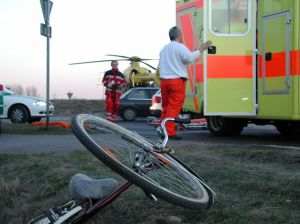
On October 4, 2010, Carroll County school bus driver Kenneth Ross Herringdine, a driver trainee, turned the ignition on his school bus and started the afternoon bus route in Carroll County, Georgia with the students of Temple High School of Temple, Georgia. Alongside him for the ride that day was a bus driver trainer, Sheri Lyn Davis.
In fact, Ms. Davis also rode in the bus the day before as she charted Mr. Herringdine’s performance. The day before the wreck, Ms. Davis had noted Herringdine’s subpar performance behind the wheel and the unwillingness of the students to board his bus for the ride home. When questioned by the police after the wreck, Ms. Davis stated that Herringdine “looks straight ahead and is slack with his mirror usage” and “does not pay attention.” Despite these observations and the fact that Herringdine had run over and killed a dog earlier on the day of the wreck while under her watch, Ms. Davis allowed Herringdine to tempt fate and roll the dice. Even worse, at the time of the fatal wreck, Herringdine had not yet received all of his certifications to operate a school bus on a full time basis.
Against this backdrop, Herringdine allegedly drifted off the road on Highway 113 across a private driveway and over a culvert where it rested into a ditch. Toxicology tests showed that Herringdine had previously ingested cough medicine which contained brompheniramine, a drug that can cause dizziness, fatigue and sleepiness. Students on the bus complained that the driver appeared drowsy. Over twelve students were injured and one student, 17 year old James Rashawn “Ray Ray” Walker, was ejected through a bus window and died when the bus rolled over him.
On July 12, 2011, Herringdine pled guilty to failure to maintain lane and was sentenced to a year’s probation and a $600 fine in a plea negotiation with the Carroll County Solicitor. Under O.C.G.A. 40-6-48(1), a motorist is required to drive within a single lane and shall not move from such lane until such time as the motorist determines that the move can be made safely. A violation of this law is considered a misdemeanor. Additionally, there are other Georgia laws of the road that bus drivers must follow. Further, a school bus is considered a “common carrier” under Georgia law which will afford further protection and a higher duty of care to the students on the bus.
Despite the resolution of the criminal charges against him, Herringdine now has to resolve the related civil claims. And Herringdine may not be alone inasmuch as the Carroll County School System has acknowledged that he lacked state certifications required to operate a bus with students on board and that evidence reflected the school system was previously aware of his deficiencies.
If Herringdine was an employee of the Carroll County school system or acted as an agent on its behalf, the school system may also be liable for the damages and the death caused by his actions and/or omissions. Further, under Georgia law, if the school system purchased a policy of insurance on the school bus, then the insurance policy should afford insurance coverage to Herringdine.
I would assume that Walker’s parents will file a suit for damages in a civil court for the death of their son. If their son had a will at the time of the death, the will should specify the executor of the estate who would be authorized to file such suit. If their son died without a will (which is most probable at his young age), then his immediate family and/or next of kin could petition the probate court to appoint an individual to act as the administrator of the estate.
Continue Reading

 Atlanta Personal Injury Lawyer Blog
Atlanta Personal Injury Lawyer Blog




![Thumbnail image for iStock_000005547552XSmall[1].jpg](https://www.atlantapersonalinjurylawyer-blog.com/files/2015/05/iStock_000005547552XSmall1.jpg)





